

Mecca soon finishes its chariot, allowing the scout in Medina to head out exploring again. I now have an actual defender in my second city. Mecca goes back to work on another worker; I'd like to have one for both cities. The first worker took 12 turns, but now thanks to the tiles I've improved, this second one will only take 5 turns. Nice! (The decision of when to build your first worker is a very strategic one in Civ4, since you don't start with one. A great addition to the game that adds a lot of depth.)
The tech Fishing comes in and I go back to work on Bronze Working. You don't lose the research you have accumulated by switching to another tech in Civ4, which is a welcome change from previous Civ games. Medina starts work on a Work Boat for its Fish resource. In 1960BC, the historian Bede ranks the most Cultured civs in the world and has me #2! No surprise that Gandhi and I are tops in the ranking, seeing as how we're the two civs that have founded religions so far. Someone will probably be getting to Judaism soon though.
Well, speak of the devil... 
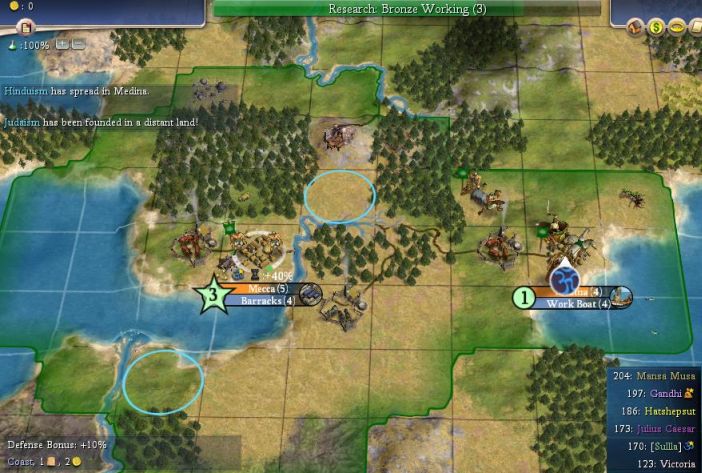
Seriously, I typed that one turn before the announcement came. I think I know this game too well... The other thing I wanted to point out is that Hinduism has spread on its own to Medina. Great! Religion will spread on its own at times; initially it will only spread to close locations, like this, but eventually you can get the religion spreading on its own to places far and wide. You can also control the spread of religion with missionaries, and that is the more common way for it to spread, but I thought I should point out that it can spread on its own too.
As for the blue circles on the ground, that's where the game is suggesting my worker go next. For once I actually agree with it, and send the newly produced worker to the grassland tile in the south to build a farm there. Mecca needs more food more than anything else right now. As far as who founded the religion, the fact that I get a popup stating "Gandhi adopted Organized Religion!" tells me that he was the one to get Judaism. (Organized Religion is one of the civics options; I'll get to them later.) Wow, BudJewism in India. That's pretty rare; much more common to see HinJewism due to the way the tech tree shakes out. No big deal at this point though.
Whoops, my scout ends his turn next to a barb warrior in 1840BC. He's dead if the barb chooses to attack him (scouts get a bonus against animals, but not against barbs). Sure enough, he gets smacked down and killed. Nuts. 
Discover Bronze Working, which now allows me to cut down forests and see the copper resource. There is a copper close to me (yay!) but it's controlled by a city Victoria just founded (no!) No other copper within a thousand miles. I'll have to hope I have iron, or else I'll be all but forced to attack Vicky. At least I have horses! Now since Bronze Working also enables the Slavery civic, let's take a look at the Civics Screen (F3 hotkey):
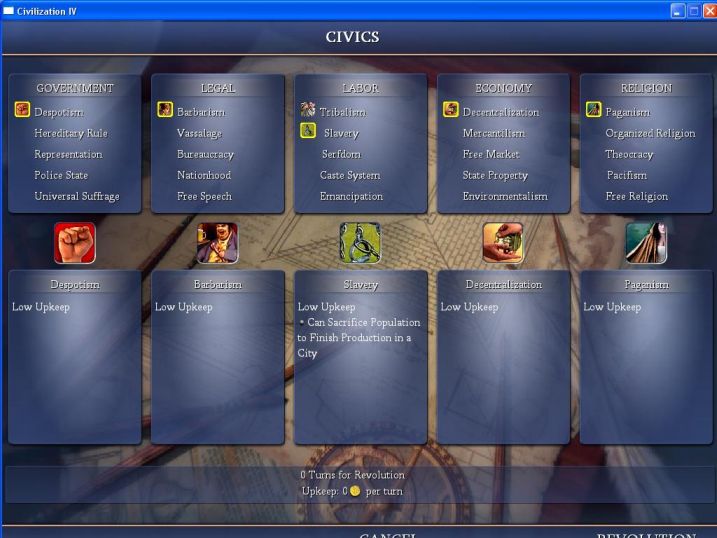
The Civics system is basically your government in Civ4. You pick from different choices in each of the 5 categories, all of which have advantages and disadvantages. Since this is still the very beginning of the game, I'm running the defaults in every category. The only choice I can pick is between Tribalism and Slavery; they both have the same Upkeep cost (Low), but Slavery gives me the added bonus of being able to whip my cities to produce things faster at the cost of sacrificing some population. As a Spiritual civ, I can swap civics without going through a turn of anarchy, so I go ahead and do so even though I don't plan on using the whip at all. You never know what it might come in handy... I'll return to this screen again as I discover later, more powerful civics.
A couple turns later, Medina finishes its Work Boat. Let's take a look at what these things do:
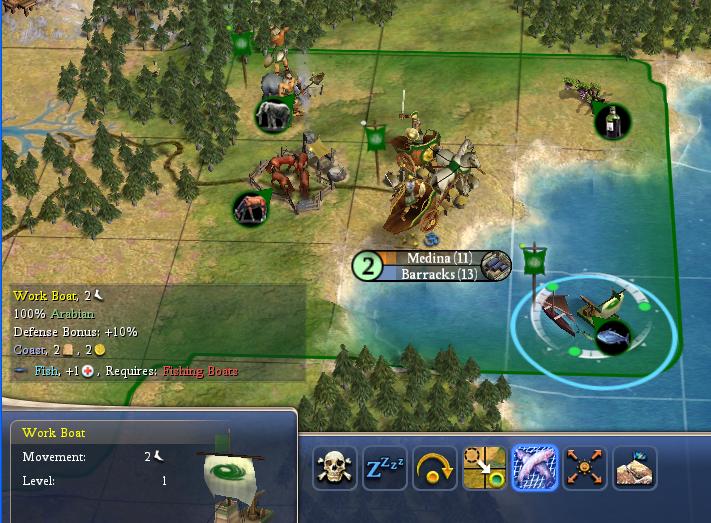
Work Boats hook up sea resources in the same way that workers hook up land resources. There's one big difference though: instead of building tile improvements, Work Boats are consumed (destroyed) in the process of building fishing nets on a resource. Here, I choose the option to build some fishing nets on the fish resource, then stand back and watch the food output skyrocket on that tile:
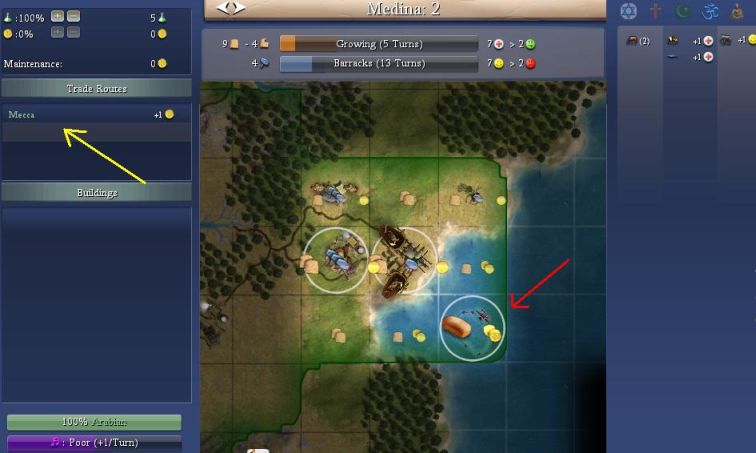
That fish tile is now producing 5 food! That's a lot!  (The bread loaf = 5 food). Now the city is growing like a weed, and it can make use of the shields from that ivory tile as soon as it grows to size 3. Things are looking good here in Medina. Also notice the trade routes section on the left side of the city screen. What does this mean? Well, Civ4 generates trade routes automatically when cities are connected to one another. Since Mecca and Medina are connected, they have a trade route with one another. Now it's a very small trade route, since we're early in the game, but with time it may be able to develop into a very lucrative one. You can also get foreign trade routes by signing Open Borders agreements with other civs, something that I'll demonstrate later on; foreign trade routes are almost always worth more money than domestic ones. At first each city can only have one trade route, but certain technologies and civics open up additional ones later on. Trade routes can bring in tons of commerce in the late game, so it's important to be aware of the fact that they're there.
(The bread loaf = 5 food). Now the city is growing like a weed, and it can make use of the shields from that ivory tile as soon as it grows to size 3. Things are looking good here in Medina. Also notice the trade routes section on the left side of the city screen. What does this mean? Well, Civ4 generates trade routes automatically when cities are connected to one another. Since Mecca and Medina are connected, they have a trade route with one another. Now it's a very small trade route, since we're early in the game, but with time it may be able to develop into a very lucrative one. You can also get foreign trade routes by signing Open Borders agreements with other civs, something that I'll demonstrate later on; foreign trade routes are almost always worth more money than domestic ones. At first each city can only have one trade route, but certain technologies and civics open up additional ones later on. Trade routes can bring in tons of commerce in the late game, so it's important to be aware of the fact that they're there.
Also notice that more resources are starting to appear in my cities as the workers hook them up; horses in the strategic resources column, cows and fish adding health, ivory adding happiness.
With the Work Boat finished, I set Mecca to building a settler (it's now at size 4 and can build one in just 8 turns) and Medina to building a chariot escort for that settler. Usually you would want to have archers serve as defenders (they are the best early-game defensive unit), but since I have horses I'm skipping Archery for now and using chariots. They are 4 strength and make pretty good defenders early on too, at least against barbs. (Barbs can capture cities in this game - beware!) Several turns pass by uneventfully, as I finish researching Pottery (granaries and cottages! yay) and Masonry (city walls and some other good stuff).
Hinduism spreads on its own to the English city of York in 1520BC. This is great news, as the city will be more likely to flip to me (it's under a lot of cultural pressure, and cities with your state religion in them are much more likely to flip). Secondly, it means that Vicky will convert to Hinduism herself and thus I'll reap increased diplomatic benefits with her. Mecca finishes its settler and - now that my workers have just built a Quarry and hooked up the Stone resouce to my north - starts work on Stonehenge, my first wonder:
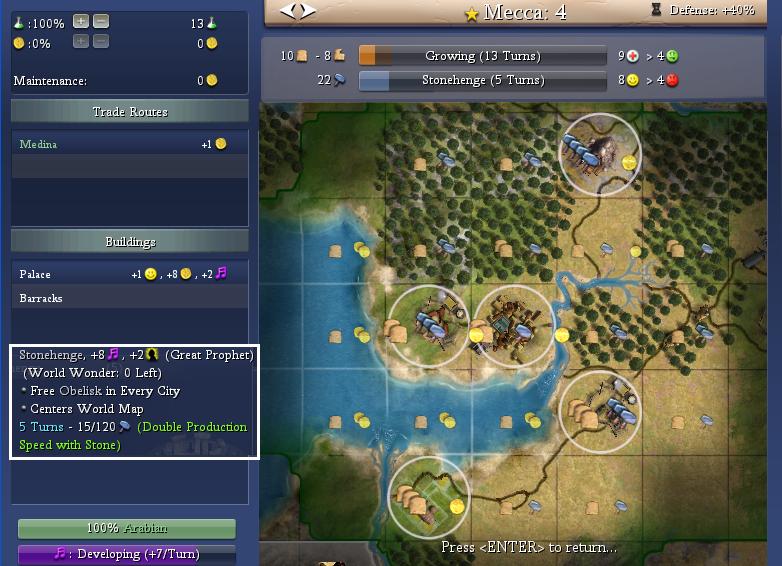
Mecca is producing 11 shields/turn, as you can see by counting them. But since I have stone connected, I get double production towards Stonehenge, and since the wonder is cheap (only 120 shields), that means I can built it in just 5 turns! Stone and marble are thus very strong strategic resources; they don't allow you to build any extra units, but boy can they ever help you get wonders. As for what Stonehenge does, it will put a free obelisk in every city on the map, thus providing free culture until it obsoletes with the discovery of the tech Calendar. That's quite good, but I'm actually more interested in Stonehenge for its free Great Person points, which I'll get to in a few minutes.
Damascus is founded two turns later on the "red dot" site I marked out ages ago, and hey - what's this?
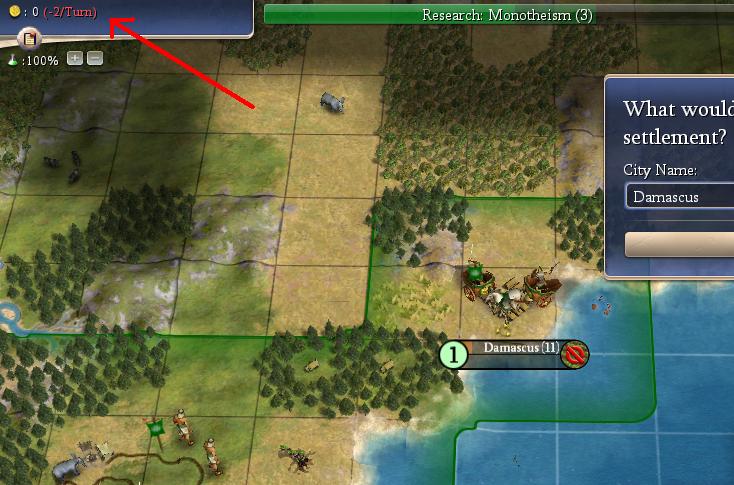
All of a sudden, my gold has gone negative. What happened? Well, in Civ4 adding more cities costs you money in maintenance costs to support them. Spamming a ton of cities everywhere without any thought behind them is a sure way to go bankrupt. There are many ways to control the costs, like building courthouses and using certain civics, but for now it's just important to remember that cities cost maintenance in Civ4. Buildings do NOT cost maintenance though. In past Civ games, buildings cost money and cities were free, so it was a good strategy to spam lots of little cities with few buildings in them all over the map. Not so in Civ4, as it's the other way around. That will take some time for people to get used to, I'm sure.  I reduce the science rate to 90% (first time I've touched it at all), and am now running in the black again.
I reduce the science rate to 90% (first time I've touched it at all), and am now running in the black again.
Not surprisingly, Mecca completes Stonehenge first in 1160BC and I am treated to a little wonder video (neat!). Now that I have a wonder, let me stop and explain how this whole Great Person system works.
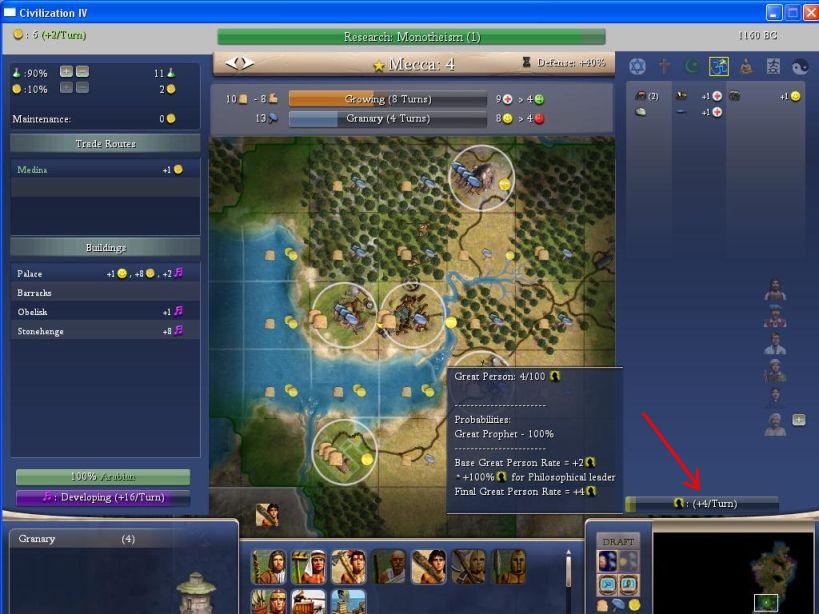
Now the Great Person bar at the bottom right of the screen has become active; by mousing over it, I get the information you see displayed in this picture. Basically, there are two ways to generate Great Person points (hereafter, GPP): through using specialists (which we aren't doing yet) and through building wonders, which automatically generate GPPs each turn. Stonehenge naturally produces 2 GPPs each turn; since Saladin is a Philosophical civ, this is increased by +100% for a total of 4 GPPs. When that bar fills up all the way, the city will produce a Great Person; right now, it will take 25 turns if I don't do anything else.
How does the game determine what type of Great Person is produced? Well, usually it's determined by the specialists that the city is running; for example, if you're using Scientist specialists, the city will be accumulating Great Scientist GPPs. In the case of wonders, each wonder produces GPPs associated with a certain type of Great Person. In the case of Stonehenge, the GPP produced are Great Prophet points. So unless I run a specialist here or build another wonder, Mecca has a 100% chance to produce a Great Prophet. I'll talk more about Great People as I go along and as I get more of them. Safe to say, Stonehenge all but guarantees an early Great Prophet (which will prove quite useful).
Shortly after building Stonehenge, I discover Monotheism (NOT founding Judaism, since it was taken by Gandhi a long time ago) and change over to the Organized Religion civic that it opens up. This civic is expensive (High upkeep!) but it allows you to build Missionaries without a monastery improvement in a city, and also boosts production by +25% when constructing buildings in cities that have your state religion present. It's quite powerful, although on higher difficulties the cost is so expensive that I'm less likely to use it. Here on Noble, it's quite manageable. And no anarchy again for changing civics - Spiritual is a fun civ trait. 
After finishing its granary, Mecca starts work on another useful early wonder, the Oracle, which grants the discoverer a free tech of their choice (yes, one of the most useless wonders in Civ3 now is very strong indeed). The Oracle would be half cost if I had marble, but unfortunately I don't. Medina built a Work Boat for Damascus and now starts on another worker, since I only have 2 for 3 cities. Here's how things stand at 1000BC:
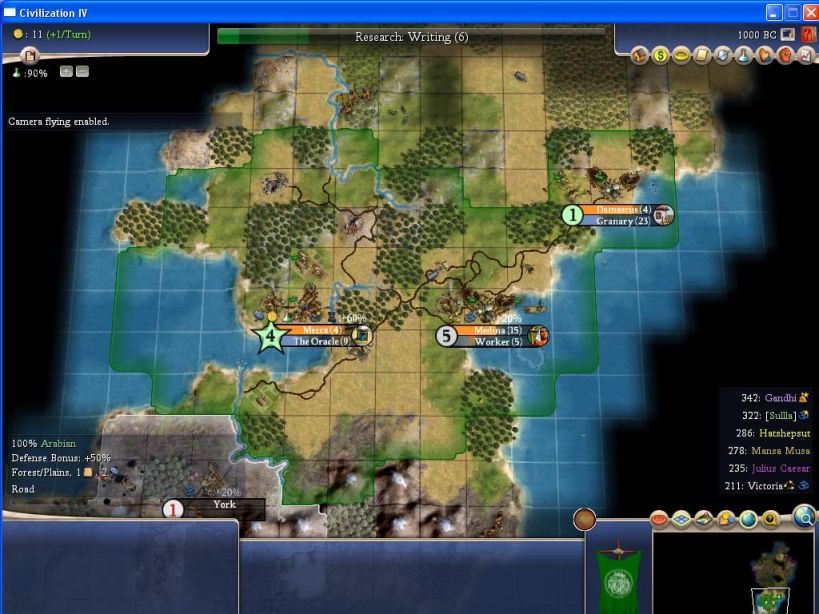
Note that even though I think I've played this thing pretty well so far, I'm still not in first place in score; Gandhi and his double-religion culture-monster civ is leading in score. Well, I'll shortly blow past these AIs and leave them in the dust, but Soren's AI really does know what it's doing. Anyone who tries to jump into Emperor right away will be in for some surprises. Things are looking good at this point.
Next time: settling more cities, building more wonders, and customizing a city to spam Great People as fast as possible.



